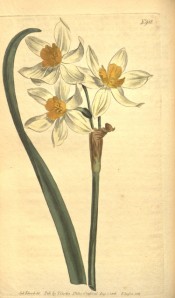Narcissus x incomparabilis Mill. var. pale yellow
Macarthur’s Narcissus orientalis pale yellow is possibly the ‘Cream-coloured Narcissus of the Levant’ illustrated in Curtis’s Botanical Magazine as a variety of Narcissus orientalis L., although Sims later changed his opinion and considered this plant to be much closer to Narcissus x incomparabilis Mill., which see. His later view is somewhat corroborated by the plates provided.
Horticultural & Botanical History
In describing the ‘Cream-coloured Narcissus of the Levant’ John Sims provides a lengthy exposition on species, varieties and hybrids, a cause of some considerable confusion in early Victorian literature. It is included in full here as it provides useful insight into the confusing nomenclature of Narcissi at the time.
‘In plants that have been long cultivated in gardens, it will often be a question not readily decided, whether certain individuals are mere varieties, arising from the advenitious circumstances of culture, or originally distinct species, or hybrids deriving their origin from intermixture. It may throw some light upon these questions to observe:
1. That whilst the industry of Florists, by means of long culture in appropriate soil and under nice management (in some cases offering a too profuse nutriment, in others subtracting the due proportion), can produce an almost endless variety of appearances in the individuals of the same species, especially in stature, colour, and multiplication of parts, yet amidst this numerous host, the scrutinising eye of the Botanist will find little or no change made in the essential characters; these mostly remain the same in all. For although, by a multiplication of the petals or other parts, the smaller and more essential organs are suffocated; yet these changes affect the generic more than the specific distinction. And notwithstanding the immense number of these artificial varieties, such is the tendency of nature to maintain a uniformity in the individuals of the same species, that a few years neglect is sufficient to reduce the thousand gaudy inhabitants of the Florist's border to the state of their original parent.
2. The same industrious spirit, when any particular flower happens to be in fashion, will seek far and near for closely related species of the same genus, and by submitting these to a suitable culture will occasion similar changes, in the endless variety of which the species may easily be confounded with the one before in cultivation.
3 This blending of different species will be still farther promoted by the accidental or purposely contrived admixture of them, by fecundating one with the pollen of another. An offspring partaking of both parents is the consequence, and in some cases perhaps a permanent intermediate variety, scarcely to be distinguished from a really distinct species, may be thus produced. For we cannot go so far, in either the vegetable or animal kingdom, as to assert with some authors, that hybrids or mules are in every case sterile. Mule birds, as we are assured by breeders, will frequently procreate, and the offspring of the wolf and the dog has been proved to be prolific; but we are not thence to conclude, as some have done, that the canary and gold-finch, the wolf and the dog are in reality the same species. We can see however that the confounding of different species by these mixed productions is very limited, in many cases confined to the individuals first produced, in others terminating perhaps with the next or third generation, and if a longer existence be allowed, we may infer a very great proximity between the parent plants. In vegetables indeed the duration may be longer from their power of propagation by other means than by seeds, but the increase obtained by offsets from the roots, cuttings, or layers, when the fostering care of man ceases, will shortly perish. Hence a very long-continued existence without change will often afford a strong presumption of a plant's being a real species.
Armed with such reflections, the Botanist may boldly enter the Florist's parterre, undismayed by the barbarous host of a Dutch catalogue. Here he will certainly find, that if the older botanical writers frequently raised varieties to the rank of species, the modern have sometimes confounded such as are really, and ever have been, distinct.
To enable us to decide in difficult cases, it becomes necessary to study varieties as well as species; and this must be our apology for admitting several of the former into a work, in the general plan of which they are excluded. Faithful representations and accurate descriptions, when recorded, cannot fail to establish the truth in the end.’ [BM t.948/1806].
History at Camden Park
Narcissus orientalis pale yellow is hand-written in a copy of the 1850 catalogue held in the Mitchell Library collection, signed Wm. Macarthur and dated 23rd December 1854. [ML 635.9m].
Notes
Published May 20, 2009 - 05:17 PM | Last updated Aug 08, 2012 - 02:51 PM

Narcissus x incomparabilis Mill. var. ‘Cream-coloured Narcissus of the Levant’ | BM t.948/1806 | BHL.
| Family | Amaryllidaceae |
|---|---|
| Category | |
| Region of origin | Probably garden origin, southern Europe |
| Synonyms | |
| Common Name | Chinese sacred lily, Levant narcissus |
| Name in the Camden Park Record | Narcissus orientalis pale yellow
|
| Confidence level | low |

